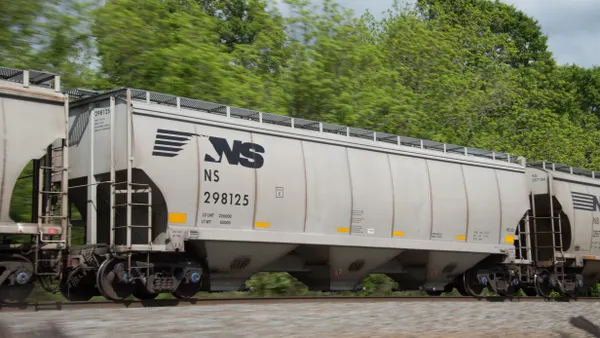Dive Brief:
- CSX pledged to reduce its carbon emissions by 37% by 2030, based on a 2014 baseline, the company announced last week. The railroad made the commitment through the Science-based Target Initiative (SBTi), which sets standards and verifies companies' efforts to reduce emissions in line with the level of decarbonization required to keep global temperature increase below 2 degrees Celsius compared to pre-industrial levels.
- The railroad will employ technology and operational strategies to increase fuel efficiency to meet the goal. Carbon offsets may also be part of the efforts, Meaghan Atkinson, CSX's manager of environmental programs told Supply Chain Dive in emailed comments. "Everything is on the table," she said.
- Of the Class I railroads, Canadian National Railway has also set targets with the SBTI (29% reduction by 2030 from a 2015 baseline) and Union Pacific committed this month to set targets within the next two years.
Dive Insight:
The railroad decided to commit to the SBTi after it reached a 2020 goal of reducing emissions 6%-8% based on a 2012 baseline two years early, according to Atkinson.
In order to tackle this new, more ambitious goal, the railroad will need to focus on fuel efficiency as 90% of the railroad's emissions come from diesel consumption, Atkinson said.
"The biggest way for CSX to move the needle is on fuel efficiency," she said. "CSX considers any and all technologies that can support fuel efficiency — some technologies include hardware and software changes to how locomotives run."
Operational changes consistent with precision-scheduled railroading (PSR) are already helping reduce emissions, since this operating philosophy seeks to reduce dwell and the total time freight spends in the railroad's network — both of which improve fuel efficiency in theory. The railroad has also streamlined and modernized its network, leading to 47% fewer wheeled parking spaces, 85% fewer trucks and 42% fewer cranes in operation, Atkinson said.
Greater efficiency and an "automated terminal gate solution" has also decreased truck wait times, which Atkinson says will reduce "emissions by thousands of tons each year when compared to a traditionally managed terminal."
CSX's drive plan generator, which optimizes locomotive power and train speed, now integrated with Positive Train Control to adjust to real-time changes, has garnered another 6% reduction in fuel consumption.
New technologies will be needed as well.
"CSX expects that new technologies will come along in the next 10 years that will assist in reaching the new goal," Atkinson said. "There are advanced technologies that do exist and part of our strategy to help achieve the goal includes investing in these new efforts."
To monitor progress, the railroad has established a dedicated fuel conservation desk at its dispatch center, which oversees remote monitoring hardware installed on 450 locomotives — a number that will double by the end of the year, Atkinson said.
Though the rails are a lower-emissions freight mode than trucking, the industry's reputation when it comes to sustainability is mixed, largely due to a historically close relationship with the coal industry.
A December report from The Atlantic alleged BNSF, CSX, Norfolk Southern and Union Pacific historically supported a pro-coal, anti-climate science trade group. When asked for comment on the allegations, a CSX spokesperson reiterated CSX's and rail transport's sustainability bonafides.
"As the most efficient mode of ground transportation, the best way to lower the carbon footprint in this arena is to move more freight by rail," the railroad said in an emailed statement. "CSX has consistently invested a portion of our annual capital on strategic projects that include fuel efficiency measures. These investments have improved locomotive fuel efficiency by 23% since 2002 and reduced the corresponding emissions."














